![]()
![]()
![]()
Use LEFT and RIGHT arrow keys to navigate between flashcards;
Use UP and DOWN arrow keys to flip the card;
H to show hint;
A reads text to speech;
29 Cards in this Set
- Front
- Back
|
General Formula |
CnH2nHO or CnH2n+1O |
|
|
Suffix |
-ol |
|
|
Functional Group |
-OH |
|
|
Shape |
O has 2 lone pairs and 2 bonding pairs so the C-O-H bond angle is 105° (tetrahedral is squeezed by lone pairs that repel each other more than bonded pairs) |
|
|
Primary (1°) Alcohols |
The C with -OH group has 1 R group. -OH at end of chain |
|
|
Secondary (2°) Alcohols |
The C with -OH group has 2 R group.-OH in the body of chain |
|
|
Teritary (3°) Alcohol |
The C with -OH group has 3 R group.-OH at a branch in chain |
|
|
Physical properties: Higher mp and bp |
OH meams hydrogen bonding occurs between the molecules which require more energy to break |
|
|
Physical properties: Solubility |
OH can make hydrogen bonds with water bit the non-polar hydrocarbon chain can't. Shorter chains are soluble because hydrogen bonding is predominant. Longer chains are insoluble because non-polar hydrocarbon is predominant |
|
|
Uses of ethanol |
Alcohols are used as intermediates as they are easily made and converted into other compounds. Used in cosmetics like perfume, manufacture or drugs, ink, detergent |
|
|
Production of Ethanol: Fermentation |
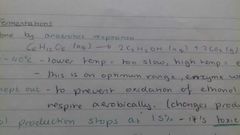
Done by using enzymes in yeast that anaerobically respire. Conditions: 30-40°C - lower temp is too slow, high temp= enzymes denature -optimum temp for enzymes to work most effectively O2 kept out -to prevent oxidisation of ethanol, yeast can respore aerobically which makes different products Ethanol production stops at 15% -it's toxic to yeast so it stops conc. Ethanol may be distilled at boiling point (78°C) |
|
|
Production of Ethanol: Crude oil |
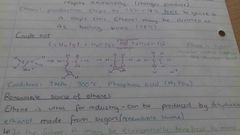
Conditions: 7MPa, 300°C, Phosphoric acid (H3PO4) |
|
|
Renewable source of ethene |
Ethene is vital for industry- can be ptoduced by dehydrating ethanol madr from sugars (renewable source). In future, it may be economicallu benefical yo make ethene from ethanol) |
|
|
Plants are carbon neutral? |
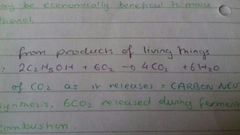
Plants take equal amount of CO2 as it released= Carbon neutral -no net release - 6CO2 used in photosynthesis, 6CO2 released during fermentation and combustion |
|
|
Plants are not carbon neutral |
Carbon neutral due to energy required to harvest, transport, distil and ferment (30-40°C) |
|
|
Biofuel |
Fuels made from products of living things |
|
|
Combustion of Alcohols |
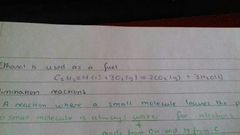
They burn completely to form water and CO2. They burn incompletely to form C or CO and water |
|
|
Elimination reaction |
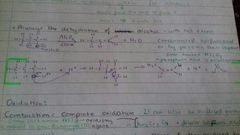
A reaction where a small molecupe leaves the parent molecule. Always wayer for alcohold (made from OH and H from C adjacent to C with OH) |
|
|
Complete oxidation |
Is combustion. It can also be oxidises gently in Kr2Cr2O7 and dilute sulfuric acid.Kr2Cr2O7 is oxidation agent, turn from orange dichromate to green dichromate |
|
|
Oxidation of Primary (1°) Alcohol |
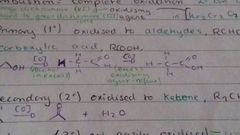
Oxidised to aldehydes, RCHO. Further oxidised to carboxylic acid, RCOOH |
|
|
Oxidation of Secondary (2°) Alcohol |

Oxidised to ketone, R2CHO. NO FURTHER OXIDATION |
|
|
Oxidation of Teritary (3°) Alcohol |
Not easily oxidised |
|
|
Why do ketones and teritary (3°) alcohols not oxidise? |
We need to break C-C bond instead of C-H bond. It is harder to break. |
|
|
Oxidisation from ethanol to ethanal |
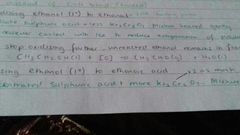
Uses dilute sulfuric acid and less Kr2Cr2O7. Mixture heated gently and reciever cooled with ice to reduce evaporation of product. To stop oxidising further, unreacted ethanol remains in flask |
|
|
Oxidising ethanol to ethanoic acid |
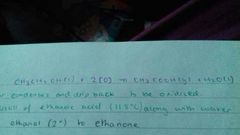
Uses concentrated sulfuric acid and more Kr2Cr2O7. Mixture is refluxed so vappur condeses and drips back to oxidised further |
|
|
Oxidising ethanol to ethanone |
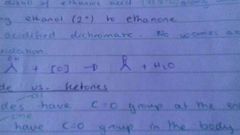
Add acidified dichromate. No worries about further oxidation |
|
|
Tollen's test |
Gentle oxidising agent. Solition of silver nitrate in aqueous ammomia. Oxidises aldehydes not ketones. Colourless silver(I) complex ions (Ag+) reduced to metallic silver Warming aldehyde with Tollen's reagent = silver mirror |
|
|
Fehling's test |
Contains blue copper (II) complex oxidises aldehydes and not ketones. Blue to brick red of copper (I) |
|
|
Carboxylic acid test |
Tested by adding NaCO3. It will fizz due to CO2 produced |

